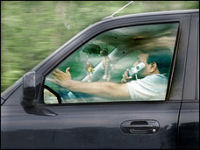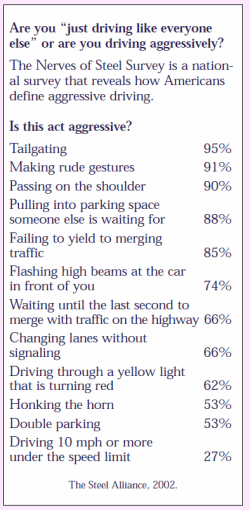Safety Driver Tips

Before we look at some very important driver safety tips, let's review the kinds errors drivers make on the road. The Indiana Tri-Level model developed by Treat et al. is one of the first driver error models, and is still widely used. The model divides driver error into four main categories as follows:
- Recognition Errors: Delayed perception, reaction, and comprehension are recognition errors. Driver distraction (internal or external), inattention, and improper lookout (i.e., looked but did not see) are examples of driver recognition errors.
- Decision Errors: A conscious decision to take a risk or to otherwise drive unsafely is referred to as a decision error. Examples include excessive speed for conditions, tailgating, misjudging another vehicle's speed or distance, taking inadequate evasive action to avoid potential conflict situations, etc.
- Performance Errors: The execution of improper motor responses is referred to as a performance error. Examples include driver panicking/freezing, improper directional control, overcorrection, etc.
- Critical Non-Performance Errors: Errors that occur due to impairment, drowsiness, fatigue, and poor driver health are examples of non-performance errors
Stay Focused

Distracted driving is a factor in 25 percent to 30 percent of all traffic crashes. With hectic schedules and roadway delays, many employees feel pressured to multitask just to keep up with their personal and work-related responsibilities.
Since drivers make more than 200 decisions during every mile traveled, it is critical for employers to stress that when driving for work, safe driving is their primary responsibility.
- Give driving you full attention. Avoid distractions such as adjusting the radio or other controls, eating or drinking,and talking on a cell phone.
- Continually observe your roadway surroundings to be alert to situations requiring quick action.
- Take a rest break every two hours. Get out of the vehicle to stretch, take a walk, and get refreshed.
Avoid Aggressive Driving

It is easy to become stressed when driving, particularly during morning or evening commutes. Aggressive driving includes excessive speed, tailgating, failure to signal a lane change, running a red light and passing on the right.
- Correct your own unsafe driving habits that are likely to endanger, antagonize or provoke other drivers.
- Keep your cool in traffic; be patient and courteous to other drivers and don't take their actions personally.
- If you think you have a problem, seek help. Look for anger or stress management classes or self-help books.
- Reduce your stress on the road by allowing plenty of time to reach your destination, plan your route in advance and alter your schedule or route to avoid busy roads.
- If despite all your planning, you're going to arrive late,accept it and avoid aggressive driving.
- Make every attempt to safely move out of an aggressive driver's way.
- If a hostile motorist tries to pick a fight, do not make eye contact and do not respond.
- Ignore gestures and refuse to return them.
- Report aggressive driving to the police. Provide a vehicle description, license number, location and the direction of travel.
Use Seat Belts
Seat belts are the single most effective means of reducing deaths and serious injuries in traffic crashes. As the most ffective safety device in vehicles, they save nearly 12,000 lives and prevent 325,000 serious injuries in America each year. During a crash, anyone not wearing a seat belt will slam into the steering wheel, windshield or other parts of the interior, or be ejected from the vehicle. Employers should develop a seat belt policy for all employees.
Never Drive After Consuming Alcohol or Drugs
Alcohol use is involved in 40 percent of all fatal motor vehicle crashes, representing an average of one alcohol-related fatality every 30 minutes. It is estimated that three in every 10 Americans will be involved in an impaired driving-related crash some time in their life. Businesses pay a high price for alcohol and drug abuse; alcohol is a contributing factor in 39 percent of all work-related traffic crashes. Alcohol, certain prescription drugs, over-the-counter medications and illegal drugs can all affect a person's ability to drive safely due to decreased alertness, concentration, coordination and reaction time. Employers should develop an alcohol and drug policy for all employees.
Fatigued Driving
Fatigued or drowsy driving may be involved in more than 100,000 crashes each year, resulting in 40,000 injuries and 1,550 deaths. Sadly, these numbers represent only the tip of the iceberg since these crashes are seriously under-reported. These days, it is more important than ever for employees to be well-rested, alert and sober on the road so that they are in a position to defend themselves from drivers who do not make the same choice. Train employees to make smart decisions when they are behind the wheel, on and off the job.
Young Drivers
The 16- to 20-year-old population represents a significant highway safety problem. Traffic crashes are the leading cause of fatalities for teens. Historically, this group is the age group that has the lowest seat belt use rate and is the most likely to engage in risky driving behaviors that include speeding and driving while alcohol or drug impaired and when drowsy. It is important for employers with young workers to actively promote safe driving practices.
Under state and federal law, 16-year-old workers are prohibited from driving as part of their job, and 17-year-olds may drive for work only under strictly limited circumstances. Some state laws may be more restrictive than federal laws. For more information on child labor laws, visit www.youthrules.dol.gov or www.cdc.gov/niosh/topics/youth/.
